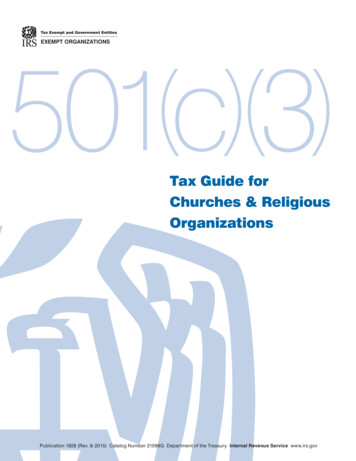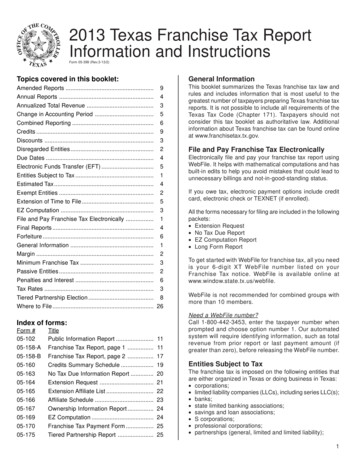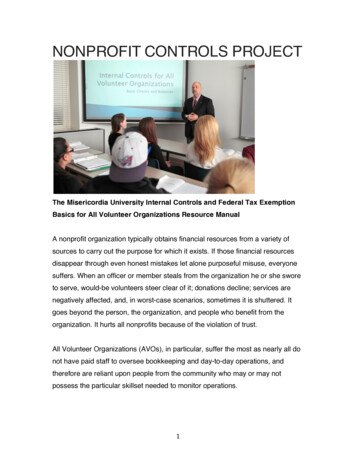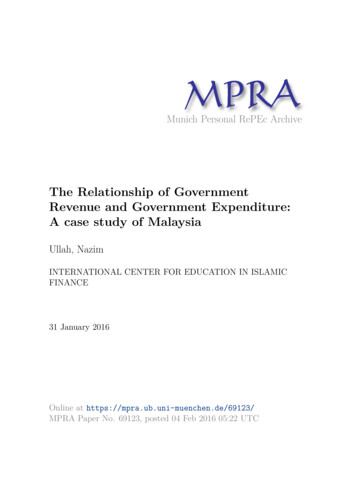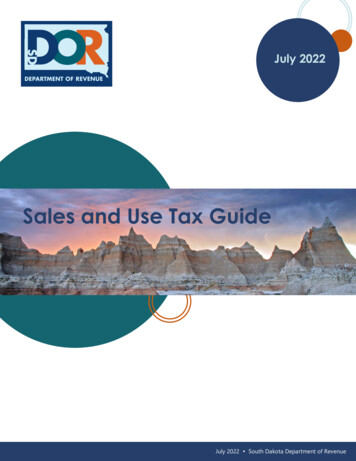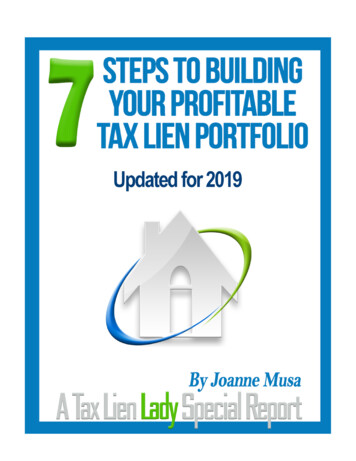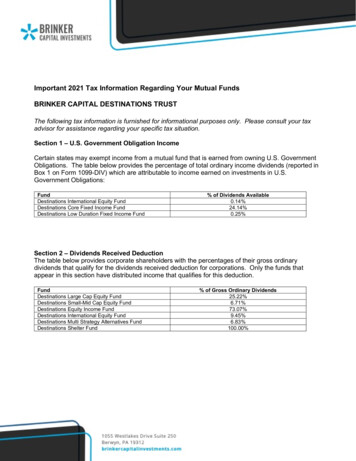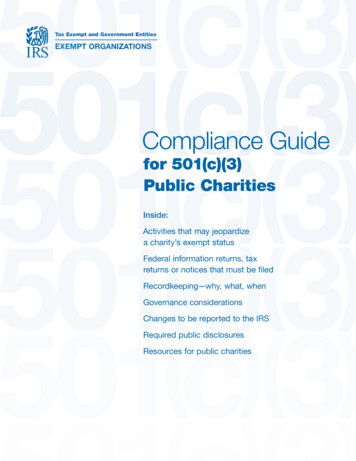
Transcription
()()501 c 3()()501 c 3()()501 c 3()()501 c 3()()501 c 3Tax Exempt and Government EntitiesEXEMPT ORGANIZATIONSCompliance Guidefor 501(c)(3)Public Charities,Inside:Activities that may jeopardizea charity’s exempt status,Federal information returns, taxreturns or notices that must be filed,Recordkeeping—why, what, when,Governance considerations,Changes to be reported to the IRS,Required public disclosures,Resources for public charities,
ContentsWhat Activities May Jeopardize aPublic Charity’s Tax-Exempt Status? .4Private Benefit and Inurement . 4Political Campaign Intervention . 4Legislative Activities . 7What Federal Information Returns,Tax Returns and Notices Must be Filed? .8Form 990, Return of Organization Exempt From Income Tax, Form 990-EZ,Short Form Return of Organization Exempt From Income Tax and Form 990-N,Electronic Notice (e-Postcard) for Tax-Exempt Organizations Not Required ToFile Form 990 or 990-EZ . 8Form 990 and Form 990-EZ . 10Form 990-N, Electronic Notice (e-Postcard) for Tax-Exempt Organizations NotRequired to File Form 990 or 990-EZ . 11Form 990-T, Exempt Organization Business Income Tax Return . 12Employment Tax Returns . 13Why Keep Records? .14Evaluate Charitable Programs. 15Monitor Budgetary Results . 15Prepare Financial Statements . 15Prepare Annual Information and Tax Returns . 15Identify Sources of Receipts . 15Substantiate Revenues, Expenses and Deductionsfor Unrelated Business Income Tax (UBIT) Purposes . 15Comply with Grant-Making Procedures (Grants to Individuals) . 16Comply with Racial Nondiscrimination Requirements (Private Schools) . 16What Records Should be Kept? .16Accounting Periods and Methods . 18Supporting Documents . 18How Long Should Records be Kept? .18Record Retention Periods . 191
What Governance Procedures and Practices Shouldan Organization Consider Adopting or Have In Place? .19Mission Statement and Organizational Documents . 19Governing Body . 19Governance and Management Policies . 20Financial Statements and Information Reporting . 20Transparency . 20How Should Changes be Reported to the IRS? . 20Reporting Changes on the Annual Information Return . 20Determination Letters and Private Letter Ruling Requests . 20What Disclosures are Required? . 21Public Inspection of Annual Returns and Exemption Applications . 21Sale of Free Government Information . 23Charitable Contributions—Substantiation and Disclosure . 23How Do You Get IRS Assistance and Information? . 25Specialized Assistance for Tax-Exempt Organizations . 25Tax Publications for Exempt Organizations . 26Forms for Exempt Organizations . 26General IRS Assistance . 272
Compliance Guide for 501(c)(3)Public CharitiesFederal tax law provides tax benefits to nonprofit organizations recognized as exemptfrom federal income tax under Internal Revenue Code (IRC) Section 501(c)(3). The IRCrequires that tax-exempt organizations must comply with federal tax law to maintain tax-exemptstatus and avoid penalties.3In this publication, the IRS addresses activities that could jeopardize a public charity’stax-exempt status. It identifies general compliance requirements on recordkeeping, reportingand disclosure for exempt organizations described in IRC Section 501(c)(3) that are classifiedas public charities. This publication is neither comprehensive nor intended to address everysituation.To learn more about compliance rules and procedures that apply to public charities exemptfrom federal income tax under Section 501(c)(3), see IRS Publication 557, Tax-Exempt Statusfor Your Organization, and the Life Cycle of a Public Charity. Also, stay abreast of new EOinformation by signing up for the Exempt Organizations Update, a free e-newsletter fortax-exempt organizations and tax practitioners who represent them. For further assistance,consult a tax adviser.
What Activities May Jeopardize aPublic Charity’s Tax-Exempt Status?Once a public charity has completed the application process and has establishedthat it is exempt under Section 501(c)(3), the charity’s officers, directors, trustees andemployees must ensure that the organization maintains its tax-exempt status andmeets its ongoing compliance responsibilities.A 501(c)(3) public charity that does not restrict its participation in certain activitiesand does not absolutely refrain from others, risks failing the operational test andjeopardizing its tax-exempt status. The following summarizes the limitations on theactivities of public charities.Private Benefit and InurementA public charity is prohibited from allowing more than an insubstantial accrual ofprivate benefit to individuals or organizations. This restriction is to ensure that a taxexempt organization serves a public interest, not a private one. If a private benefit ismore than incidental, it could jeopardize the organization’s tax-exempt status.No part of an organization’s net earnings may inure to the benefit of an insider. Aninsider is a person who has a personal or private interest in the activities of theorganization such as an officer, director or a key employee. This means that anorganization is prohibited from allowing its income or assets to accrue to insiders.An example of prohibited inurement would include payment of unreasonablecompensation to an insider. Any amount of inurement may be grounds for loss of taxexempt status.If a public charity provides an economic benefit to any person who is able toexercise substantial influence over its affairs (that exceeds the value of any goodsor services provided in consideration), the organization has engaged in an excessbenefit transaction. A public charity that engages in an excess benefit transactionmust report it to the IRS. Excise taxes are imposed on any person who engages inan excess benefit transaction with a public charity, and on any organization manager who knowingly approves the transaction. (See Reporting Excess BenefitTransactions on page 11).A public charity that becomes aware that it may have engaged in an excess benefittransaction should consult a tax advisor and take appropriate action to avoid anypotential impact it could have on the organization’s tax-exempt status. Visitwww.irs.gov/charities-non-profits for details about inurement, private benefit andexcess benefit transactions.Political Campaign InterventionPublic charities are prohibited from directly or indirectly participating in, or interveningin, any political campaign on behalf of (or in opposition to) any candidate for electivepublic office. Contributions to political campaign funds or public statements of4
position (verbal or written) made on behalf of the organization in favor of, or inopposition to, any candidate for public office clearly violate the prohibition againstpolitical campaign activity. Violation of this prohibition may result in revocation oftax-exempt status and/or imposition of certain excise taxes.Certain activities or expenditures may not be prohibited depending on the factsand circumstances. For example, certain voter education activities (includingthe presentation of public forums and the publication of voter education guides)conducted in a non-partisan manner do not constitute prohibited politicalcampaign activity. Other activities intended to encourage people to participate inthe electoral process, such as voter registration and get-out-the-vote drives, wouldnot constitute prohibited political campaign activity if conducted in a non-partisanmanner. On the other hand, voter education or registration activities conducted ina biased manner that favors one candidate over another, opposes a candidate insome manner or has the effect of favoring a candidate or group of candidates, willconstitute prohibited campaign intervention.The political campaign activity prohibition is not intended to restrict freeexpression on political matters by leaders of public charities speaking forthemselves as individuals. However, for their organizations to remain tax exemptunder Section 501(c)(3), organization leaders cannot make partisan comments inofficial organization publications or at official functions. When speaking in a nonofficial capacity, these leaders should clearly indicate that their comments arepersonal, and not intended to represent the views of the organization.Some Section 501(c)(3) organizations take positions on public policy issues,including issues that divide candidates in an election for public office. However,Section 501(c)(3) organizations must avoid any issue advocacy that functions aspolitical campaign intervention. Even if a statement does not expressly tell anaudience to vote for or against a specific candidate, an organization delivering thestatement is at risk of violating the political campaign intervention prohibition ifthere is any message favoring or opposing a candidate. A statement can identifya candidate not only by stating the candidate’s name but also by other meanssuch as showing a picture of the candidate, referring to political party affiliationsor other distinctive features of a candidate’s platform or biography. All the factsand circumstances need to be considered to determine if the advocacy is politicalcampaign intervention.The IRS considers the following factors that tend to show an advocacycommunication is political campaign activity: whether the statement identifies one or more candidates for a givenpublic office,whether the statement expresses approval or disapproval for one or morecandidates’ positions and/or actions,whether the statement is delivered close in time to the election,5
whether the statement refers to voting or an election,whether the issue addressed in the communication has been raised as anissue distinguishing candidates for a given office,whether the communication is part of an ongoing series of communications bythe organization on the same issue that are made independent of the timing ofany election, and,whether the timing of the communication and identification of the candidateare related to a non-electoral event such as a scheduled vote on specificlegislation by an officeholder who also happens to be a candidate for publicoffice.A communication is particularly at risk of political campaign intervention when itrefers to candidates or voting in a specific upcoming election. Nevertheless, thecommunication must still be considered in context before arriving at any conclusions.Political candidates may be invited to appear or speak at organization events intheir capacity as candidates, or in their individual capacity (not as a candidate).Candidates may also appear without an invitation at organization events that areopen to the public.When candidates are invited to speak at a public charity’s event in their capacityas political candidates, factors in determining whether the organization participatedor intervened in a political campaign include: whether the public charity provides an equal opportunity to participate to thepolitical candidates seeking the same office,whether the public charity indicates any support of, or opposition to, thecandidate (including candidate introductions and communication concerningthe candidate’s attendance), andwhether any political fundraising occurs.When a candidate is invited to speak at a public charity’s event in a non-candidatecapacity, factors in determining whether the candidate’s appearance results in apolitical campaign intervention for the organization include: whether the individual is chosen to speak solely for reasons other thancandidacy for public office,whether the individual speaks only in a non-candidate capacity or referenceshis or her candidacy or the election,whether the individual or any representative of the organization makes anymention of the individual’s candidacy or the election,whether any campaign activity occurs in connection with the individual’sappearance,whether the organization maintains a nonpartisan atmosphere on the premisesor at the event where the individual is present, andwhether the organization clearly indicates the capacity in which the individualis appearing and does not mention the individual’s political candidacy orthe upcoming election in the communications announcing the indivdual’sattendance at the event.6
In determining whether candidates are given an equal opportunity to participate,the nature of the event to which each candidate is invited, should be consideredin addition to the manner of presentation. For example, a public charity thatinvites one candidate to speak at its well-attended annual banquet, but invites theopposing candidate to speak at a sparsely attended general meeting, will likelyviolate the political campaign prohibition, even if the manner of presentation forboth speakers is otherwise neutral.Sometimes a public charity invites several candidates to speak at a public forum.A public forum involving several candidates for public office may qualify as anexempt educational activity. However, if the forum is operated to show a bias foror against any candidate, then the forum would be prohibited campaign activity, asit would be considered intervention or participation in a political campaign. Whenan organization invites several candidates for the same office to speak at a forum,determining whether the forum results in political campaign intervention include: whether questions for the candidate are prepared and presented by anindependent nonpartisan panel;whether the topics discussed by the candidates cover a broad range of issuesthat the candidates would address if elected to the office sought and are ofinterest to the public;whether each candidate is given an equal opportunity to present his or herviews on the issues discussed;whether the candidates are asked to agree or disagree with positions,agendas, platforms or statements of the organization; andwhether a moderator comments on the questions or otherwise impliesapproval or disapproval of the candidates.Revenue Ruling 2007-41 provides additional information on the prohibition againstpolitical campaign intervention.Legislative ActivitiesA public charity is not permitted to engage in substantial legislative activities(commonly known as lobbying). An organization will be regarded as attemptingto influence legislation if it contacts, or urges the public to contact, members oremployees of a legislative body for purposes of proposing, supporting or opposinglegislation, or advocates the adoption or rejection of legislation.If lobbying activities are substantial, a 501(c)(3) organization may fail the operationaltest and risk losing its tax-exempt status and/or be liable for excise taxes.Substantiality is measured by either the substantial part test or the expendituretest. The substantial part test determines substantiality based on all the facts andcircumstances in each case. The IRS considers a variety of factors, including thetime devoted (by both compensated and volunteer workers) and expendituresdevoted by the organization to the activity, when determining whether the lobbyingactivity is substantial.As an alternative, a public charity (other than a church) may elect to use theexpenditure test by filing Form 5768, Election/Revocation of Election by an Eligible7
Section 501(c)(3) Organizations To Make Expenditures To Influence Legislation.Under the expenditure test, the extent of a public charity’s lobbying activities willnot jeopardize its tax-exempt status, provided its expenditures, related to theactivities do not normally exceed a set amount specified in IRC Section 4911. Thislimit is generally based on the size of the organization and may not exceed 1million.Also, under the expenditure test, a public charity that engages in excessivelobbying activity over a four-year period may lose its tax-exempt status, makingall its income for that period subject to tax. Should the organization exceed itslobbying expenditure dollar limit in a year, it must pay an excise tax equal to25 percent of the excess. Visit the Life Cycle of a Public Charity for additionalinformation about the rules against substantial legislative activities.Public charities that engage in lobbying activities must report lobbying activities onForm 990, Schedule C, Political Campaign and Lobbying Activities.What Federal Information Returns,Tax Returns and Notices Must be Filed?While 501(c)(3) public charities are exempt from federal income tax, most of theseorganizations have information reporting obligations under the IRC to ensure thatthey continue to be recognized as tax-exempt. In addition, they may also be liablefor employment taxes, unrelated business income tax, excise taxes and certainstate and local taxes.Form 990, Return of Organization Exempt From Income Tax, Form990-EZ, Short Form Return of Organization Exempt From IncomeTax and Form 990-N, Electronic Notice (e-Postcard) for Tax-ExemptOrganizations Not Required To File Form 990 or 990-EZPublic charities generally file either a: Form 990, Return of Organization Exempt From Income Tax, Form 990-EZ, Short Form Return of Organization Exempt From Income Tax, or Form 990-N, Electronic Notice (e-Postcard) for Tax-Exempt Organizations NotRequired To File Form 990 or 990-EZ.The type of Form 990 series return a public charity must file is generallydetermined by the organization’s financial activity as indicated in the chart below.Filing DatesForms 990, 990-EZ and 990-N must be filed by the 15th day of the fifth monthafter the end of the organization’s tax year. The due date for the Forms 990and 990-EZ may be automatically extended for six months by filing Form 8868,Application for Automatic Extension of Time To File an Exempt OrganizationReturn, before the due date.An organization cannot request an extension for filing the Form 990-N; however,there is no penalty for filing it late.See Filing Penalties and Revocation of Tax-Exempt Status on page 12.8
Gross Receipts Thresholds,Formto File,Gross receipts normally 50,000,990-N,Gross receipts 200,000and Total assets 500,000,990-EZor 990,Gross receipts 200,000 or Total assets 500,000990,Filing ExceptionsPublic charities not required to file an annual information returninclude certain: religious organizations; governmental organizations; political organizations; organizations that file different kinds of annual information returns; subordinate organizations included in a group return filed by the centralorganization; andorganizations whose annual gross receipts are normally 50,000 or less and,therefore, are eligible to file an annual electronic notice (see Form 990-N,Electronic Notice (e-Postcard) for Tax-Exempt Organizations Not RequiredTo File Form 990 or 990-EZ on page 11).If a public charity is excepted from filing a Form 990 or Form 990-EZ becauseannual gross receipts are normally 50,000 or less, and it elects to file the Form990 or Form 990-EZ, it must complete the entire return. An organization that onlycompletes those items of information on the Form 990 or Form 990-EZ that arerequired to be provided on an electronic Form 990-N will not be deemed to havemet its electronic notice requirement.Special Requirements for SupportingOrganizations and Donor Advised FundsPublic charities that are supporting organizations described in Section 509(a)(3) mustfile Form 990 or Form 990-EZ even if their gross receipts are normally 50,000or less. Supporting organizations of certain religious organizations need not fileForm 990 or Form 990-EZ if their gross receipts are normally 5,000 or less. Theseorganizations must, however, file the Form 990-N.Supporting organizations must indicate whether they are a Type I, Type II or Type III(and Functionally or Non-Functionally Integrated) supporting organization, identifytheir supported organizations and annually certify that they are not directly orindirectly controlled by a disqualified person. See the instructions for Schedule A(Form 990 or Form 990-EZ), Public Charity Status and Public Support, and Notice2006-109 to determine an organization’s appropriate supporting organizationtype for information return purposes. For a brief overview of the requirements forqualification as a supporting organization and the different types of supportingorganization, see Publication 557 and www.irs.gov/charities-non-profits.9
Sponsoring organizations of donor advised funds (defined as organizations thatmaintain one or more donor advised funds), and organizations that have controlledentities must file Form 990, not Form 990-EZ, if required to file an annualinformation return for the year.Form 990 and Form 990-EZForm 990 consists of a core form and schedules. Each organization that files theform must complete the entire core form. The core Form 990 includes a SummaryPage that provides a “snapshot” of the organization’s key financial and operatinginformation for the current and prior year.All Form 990 filers will provide information about their program serviceaccomplishments, compensation of certain officers, directors and key employeesas well as information about governance practices and procedures and financialinformation.Each organization that files Form 990 must complete Part IV of Form 990,Checklist of Required Schedules, to determine which schedules it must completebased on its activities. See the instructions for Form 990-EZ for information aboutwhich schedules 990-EZ filers must complete.Schedule A, Public Charity Status and Public Support, andSchedule B, Schedule of ContributorsPublic charities that file Form 990 or Form 990-EZ must file Schedule A, PublicCharity Status and Public Support.A new IRC Section 501(c)(3) organization will be classified as a public charity, andnot a private foundation, during its first five years if it can show when it applies fortax-exempt status that it can reasonably expect to be publicly supported.The IRS will monitor a new organization’s public charity status after the first fiveyears of existence based on the public support information reported annually bythe organization on Schedule A based on a five-year computation period thatincludes the current year and the four prior years (including short years).Beginning with the organization’s sixth year and for all succeeding years, if anorganization meets the public support test on Schedule A, the organizationqualifies as a public charity for its current year and the next tax year.If a publicly supported charity fails the public support test for two consecutiveyears, it will be reclassified as a private foundation.See Publication 4220, Applying for 501(c)(3) Tax-Exempt Status, for details on thedistinctions between public charities and private foundations.Most public charities that received contributions of 5,000 or more from any onecontributor must file Schedule B, Schedule of Contributors. See Part IV, line 2 ofForm 990 and the instructions to Schedule B (Form 990, 990-EZ) for completeinstructions.10
Also, see www.irs.gov/charities-non-profits for additional information about otherschedules that a public charity may be required to complete based on the natureof its activities.Reporting Excess Benefit TransactionsIf a public charity believes it provided an excess benefit to a person who is ableto exercise substantial influence over the organization’s affairs, it must reportthe transaction on Form 990 or Form 990-EZ. Excess benefit transactions aregoverned by IRC Section 4958. See Appendix G of the Form 990 Instructions for adiscussion of Section 4958, and Schedule L, Part I, regarding reporting of excessbenefit transactions.Form 990-N, Electronic Notice (e-Postcard) for Tax-ExemptOrganizations Not Required To File Form 990 or 990-EZAny public charity that is not required to file Form 990 or 990-EZ because itsannual gross receipts are normally 50,000 or less must instead file Form 990-N,Electronic Notice (e-Postcard) for Tax-Exempt Organizations Not Required To FileForm 990 or Form 990-EZ. Exceptions to this requirement include organizationsthat are included in a group return; churches, their integrated auxiliaries andconventions or associations of churches; and organizations required to file adifferent return.The Form 990-N is due by the 15th day of the fifth month after the close of theorganization’s tax year. For example, if your organization’s tax year ends onDecember 31, the Form 990-N is due May 15 of the following year. The e-Postcardcannot be filed until the organization’s tax year ends.The form must be completed and filed electronically. There is no paper form.An organization is required to provide the following information on Form 990-N: legal name, any other names the organization uses, mailing address, website address (if applicable), employer identification number (EIN), also known as a taxpayer identificationnumber (TIN), name and address of a principal officer, annual tax year, confirmation that the organization’s annual gross receipts are 50,000 or less,andif applicable, a statement that the organization has terminated or is terminating(going out of business).Read Filing Penalties and Revocation of Tax-Exempt Status below on theconsequences for failure to file this annual electronic notice11
FILING PENALTIES AND REVOCATION OF TAX-EXEMPT STATUSIf a Form 990 or Form 990-EZ is not filed, the IRS may assess penalties on the organization of 20 perday until it is filed. This penalty also applies when the filer fails to include required information or to showcorrect information. The penalty for failure to file a return or a complete return may not exceed the lesser of 10,000 or 5 percent of the organization’s gross receipts. For an organization that has gross receipts of over 1 million for the year, the penalty is 100 a day up to a maximum of 50,000. The IRS may impose penaltieson organization managers who do not comply with a written demand that the information be filed.IRC Section 6033(j) provides that failure to file Form 990, Form 990-EZ or Form 990-N for three consecutiveyears results in revocation of tax-exempt status as of the filing due date for the third return. An organizationwhose exemption is revoked under this section must apply for reinstatement by filing a new applicationand paying a user fee, whether or not the organization was originally required to file for exemption.Reinstatement of exemption may be retroactive if the organization shows that the failure to file was forreasonable cause.E-Filing RequirementsPublic charities with 10 million or more in t
Public Charity's Tax-Exempt Status? Once a public charity has completed the application process and has established that it is exempt under Section 501(c)(3), the charity's officers, directors, trustees and employees must ensure that the organization maintains its tax-exempt status and meets its ongoing compliance responsibilities.

